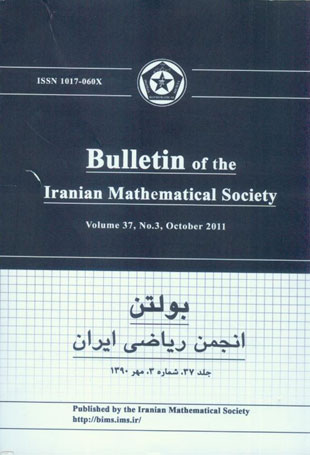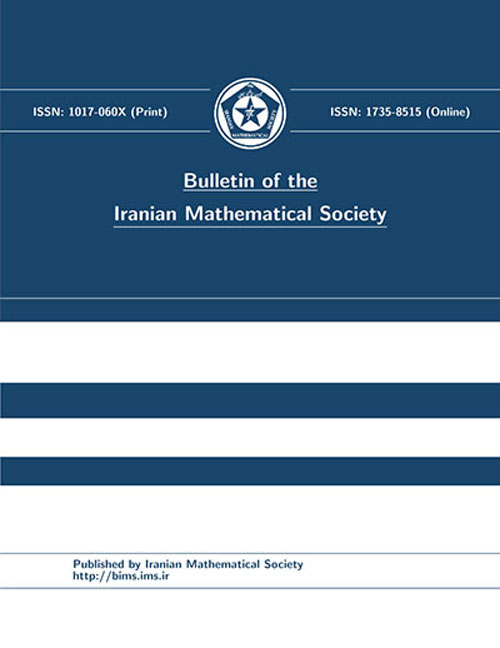فهرست مطالب

Bulletin of Iranian Mathematical Society
Volume:37 Issue: 3, 2011
- تاریخ انتشار: 1390/10/11
- تعداد عناوین: 20
-
-
Page 1We consider a class of hypergraphs called hypercycles and we show that a hypercycle $C_n^{d,alpha}$ is shellable or sequentially the Cohen--Macaulay if and only if $nin{3,5}$. Also, we characterize Cohen--Macaulay hypercycles. These results are hypergraph versions of results proved for cycles in graphs.
-
Page 11Hadamard (or complete $CAT(0)$) spaces are complete, non-positive curvature, metric spaces. Here, we prove a nonlinear ergodic theorem for continuous non-expansive semigroup in these spaces as well as a strong convergence theorem for the commutative case. Our results extend the standard non-linear ergodic theorems for non-expansive maps on real Hilbert spaces, to non-expansive maps on Hadamard spaces, which include for example (possibly infinite dimensional) complete simply connected Riemannian manifolds with non-positive sectional curvature.
-
Page 21This paper is an investigation of $L$-dual frames with respect to a function-valued inner product, the so called $L$-bracket product on $L^{2}(G)$, where G is a locally compact abelian group with a uniform lattice $L$. We show that several well known theorems for dual frames and dual Riesz bases in a Hilbert space remain valid for $L$-dual frames and $L$-dual Riesz bases in $L^{2}(G)$.
-
Page 33{sl Let $[n]={1,dots, n}$ be colored in $k$ colors. A rainbow AP$(k)$ in $[n]$ is a $k$ term arithmetic progression whose elements have different colors. Conlon, Jungi'{c} and Radoiv{c}i'{c} cite{conlon} prove that there exists an equinumerous 4-coloring of $[4n]$ which is rainbow AP(4) free, when $n$ is even. Based on their construction, we show that such a coloring of $[4n]$ also exists for odd $n>1$. We conclude that for nonnegative integers $kgeq 3$ and $n > 1$, every equinumerous $k$-coloring of $[kn]$ contains a rainbow AP$(k)$ if and only if $k=3$.}
-
Page 39We investigate Buchbaum and Eisenbud's construction of the second symmetric power $s_R(X)$ of a chain complex $X$ of modules over a commutative ring $R$. We state and prove a number of results from the folklore of the subject for which we know of no good direct references. We also provide several explicit computations and examples. We use this construction to prove the following version of a result of Avramov, Buchweitz, and c{S}ega: let $Rto S$ be a module-finite ring homomorphism such that $R$ is noetherian and local, and such that 2 is a unit in $R$. Let $X$ be a complex of finite rank free $S$-modules such that $X_n=0$ for each $n<0$. If $cup_nass_R(HH_n(Xotimes_SX))subseteqass(R)$ and if $X_{p}simeq S_{p}$ for each $pinass(R)$, then $Xsimeq S$.
-
Page 77We derive whole series of new integral inequalities of the Hardy-type, with non-conjugate exponents. First, we prove and discuss two equivalent general inequa-li-ties of such type, as well as their corresponding reverse inequalities. General results are then applied to special Hardy-type kernel and power weights. Also, some estimates of weight functions and constant factors are obtained. In particular, we obtain generalizations and improvements of some recent results, in the literature.
-
Page 109The binary and ternary codes spanned by the rows of the point by block incidence matrices of some 2-designs and their complementary and orthogonal designs are studied. A new method is also introduced to study optimal codes.
-
Page 117Let $R$ be a commutative Noetherian ring with non-zero identity, $fa$ an ideal of $R$, and $X$ an $R$--module. Here, for fixed integers $s, t$ and a finite $fa$--torsion $R$--module $N$, we first study the membership of $Ext^{s+t}_{R}(N, X)$ and $Ext^{s}_{R}(N, H^{t}_{fa}(X))$ in the Serre subcategories of the category of $R$--modules. Then, we present some conditions which ensure the existence of an isomorphism between them. Finally, we introduce the concept of the Serre cofiniteness as a generalization of cofiniteness and study this property for certain local cohomology modules.
-
Page 135We develop and apply the product integration method to a large class of linear weakly singular Volterra systems. We show that under certain sufficient conditions this method converges. Numerical implementation of the method is illustrated by a benchmark problem originated from heat conduction.
-
Page 149We show that every semi-artinian module which is contained in a direct sum of finitely presented modules in $si[M]$, is weakly co-semisimple if and only if it is regular in $si[M]$. As a consequence, we observe that every semi-artinian ring is regular in the sense of von Neumann if and only if its simple modules are $FP$-injective.
-
Page 159We study topological von Neumann regularity and principal von Neumann regularity of Banach algebras. Our main objective is comparing these two types of Banach algebras and some other known Banach algebras with one another. In particular, we show that the class of topologically von Neumann regular Banach algebras contains all $C^*$-algebras, group algebras of compact abelian groups and certain weakly amenable Banach algebras while it excludes measure algebras, of certain locally compact Abelian groups. Moreover, we show that in a unital amenable Banach algebra, principal regularity implies topological regularity. Finally, we use topological regularity to obtain some information about hereditary $C^*$-subalgebras of a given $C^*$-algebra.
-
Page 171A necessary and sufficient condition in terms of lower cut sets are given for the insertion of a $gamma-$continuous function between two comparable real-valued functions.
-
Page 183In this article, we introduce monomial irreducible representations of the special linear Lie algebra $sln$. We will show that this kind of representations have bases for which the action of the Chevalley generators of the Lie algebra on the basis elements can be given by a simple formula.
-
Page 197Here, a predator-prey model with Hassell-Varley type functional responses is studied. Some sufficient conditions are obtained for the permanence and global asymptotic stability of the system by using comparison theorem and constructing a suitable Lyapunov functional. Moreover, an example is illustrated to verify the results by simulation.
-
Page 217Let $D$ be an integral domain and $star$ a semistar operation stable and of finite type on it. We define the semistar dimension (inequality) formula and discover their relations with $star$-universally catenarian domains and $star$-stably strong S-domains. As an application, we give new characterizations of $star$-quasi-Pr"{u}fer domains and UM$t$ domains in terms of dimension inequality formula (and the notions of universally catenarian domain, stably strong S-domain, strong S-domain, and Jaffard domain). We also extend Arnold's formula to the setting of semistar operations.
-
Page 235We establish a sharp maximal function estimate for some vector-valued multilinear singular integral operators. As an application, we obtain the $(L^p, L^q)$-norm inequality for vector-valued multilinear operators.
-
Page 249Recently, we have used the symmetric bracket of vector fields, and developed the notion of the symmetric derivation. Using this machinery, we have defined the concept of symmetric curvature. This concept is natural and is related to the notions divergence and Laplacian of vector fields. This concept is also related to the derivations on the algebra of symmetric forms which has been discussed by the authors. We introduce a new class of geometric vector fields and prove some basic facts about them. We call these vector fields affinewise. By contraction of the symmetric curvature, we define two new curvatures which have direct relations to the notions of divergence, Laplacian, and the Ricci tensor.
-
Page 269Let $Rin textbf{C}^{mtimes m}$ and $Sin textbf{C}^{ntimes n}$ be nontrivial involution matrices; i.e., $R=R^{-1}neq pm~I$ and $S=S^{-1}neq pm~I$. An $mtimes n$ complex matrix $A$ is said to be an $(R, S)$-symmetric ($(R, S)$-skew symmetric) matrix if $RAS =A$ ($ RAS =-A$). The $(R, S)$-symmetric and $(R, S)$-skew symmetric matrices have a number of special properties and widely used in engineering and scientific computating. Here, we introduce the necessary and sufficient conditions for the solvability of the pair of matrix equations $A_{1}XB_{1}=C_{1}$ and $A_{2}XB_{2}=C_{2}$, over $(R, S)$-symmetric and $(R, S)$-skew symmetric matrices, and give the general expressions of the solutions for the solvable cases. Finally, we give necessary and sufficient conditions for the existence of $(R, S)$-symmetric and $(R, S)$-skew symmetric solutions and representations of these solutions to the pair of matrix equations in some special cases.
-
Page 281Let $G$ be a $p$-group of order $p^n$ and $Phi$=$Phi(G)$ be the Frattini subgroup of $G$. It is shown that the nilpotency class of $Autf(G)$, the group of all automorphisms of $G$ centralizing $G/ Fr(G)$, takes the maximum value $n-2$ if and only if $G$ is of maximal class. We also determine the nilpotency class of $Autf(G)$ when $G$ is a finite abelian $p$-group.
-
Page 291It has been proved that sphericity testing for digraphs is an NP-complete problem. Here, we investigate sphericity of 3-connected single source digraphs. We provide a new combinatorial characterization of sphericity and give a linear time algorithm for sphericity testing. Our algorithm tests whether a 3-connected single source digraph with $n$ vertices is spherical in $O(n)$ time.


